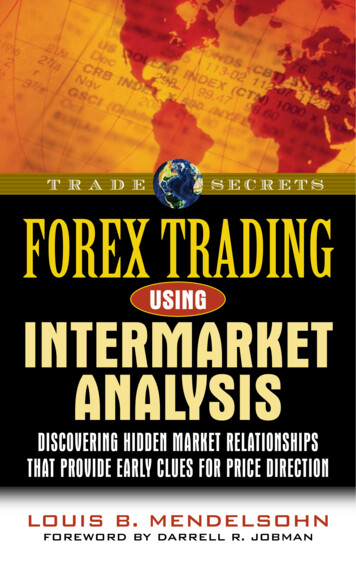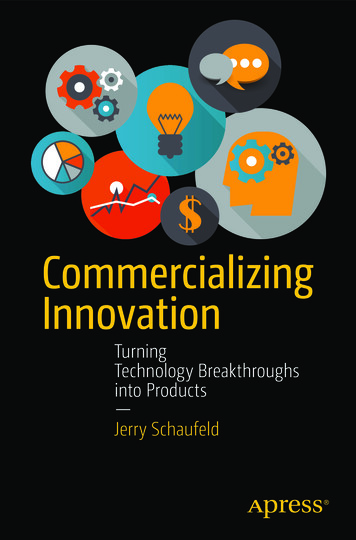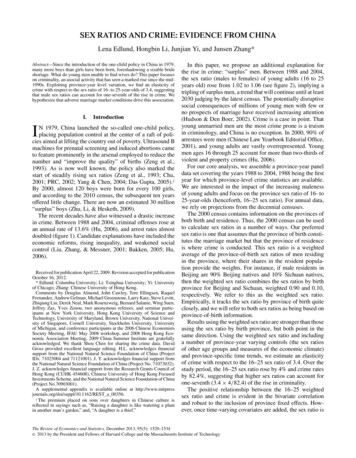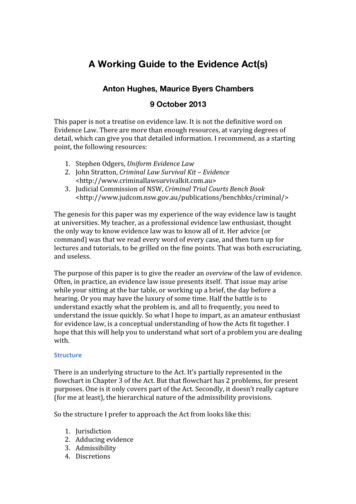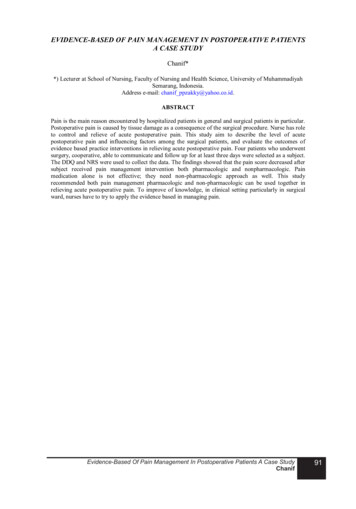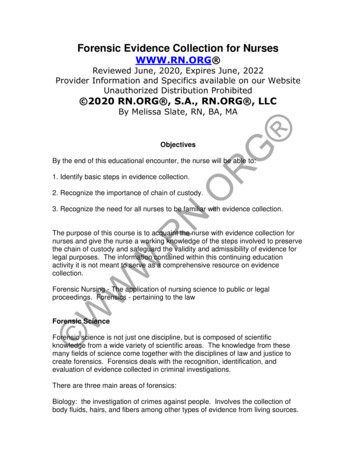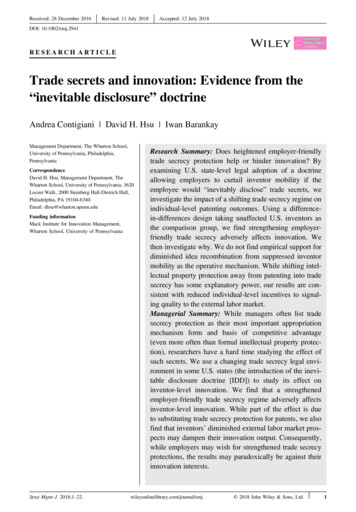
Transcription
Received: 28 December 2016Revised: 11 July 2018Accepted: 12 July 2018DOI: 10.1002/smj.2941RESEARCH ARTICLETrade secrets and innovation: Evidence from the“inevitable disclosure” doctrineAndrea Contigiani David H. Hsu Iwan BarankayManagement Department, The Wharton School,University of Pennsylvania, Philadelphia,PennsylvaniaCorrespondenceDavid H. Hsu, Management Department, TheWharton School, University of Pennsylvania, 3620Locust Walk, 2000 Steinberg Hall-Dietrich Hall,Philadelphia, PA 19104-6340.Email: dhsu@wharton.upenn.eduFunding informationMack Institute for Innovation Management,Wharton School, University of PennsylvaniaStrat Mgmt J. 2018;1–22.Research Summary: Does heightened employer-friendlytrade secrecy protection help or hinder innovation? Byexamining U.S. state-level legal adoption of a doctrineallowing employers to curtail inventor mobility if theemployee would “inevitably disclose” trade secrets, weinvestigate the impact of a shifting trade secrecy regime onindividual-level patenting outcomes. Using a differencein-differences design taking unaffected U.S. inventors asthe comparison group, we find strengthening employerfriendly trade secrecy adversely affects innovation. Wethen investigate why. We do not find empirical support fordiminished idea recombination from suppressed inventormobility as the operative mechanism. While shifting intellectual property protection away from patenting into tradesecrecy has some explanatory power, our results are consistent with reduced individual-level incentives to signaling quality to the external labor market.Managerial Summary: While managers often list tradesecrecy protection as their most important appropriationmechanism form and basis of competitive advantage(even more often than formal intellectual property protection), researchers have a hard time studying the effect ofsuch secrets. We use a changing trade secrecy legal environment in some U.S. states (the introduction of the inevitable disclosure doctrine [IDD]) to study its effect oninventor-level innovation. We find that a strengthenedemployer-friendly trade secrecy regime adversely affectsinventor-level innovation. While part of the effect is dueto substituting trade secrecy protection for patents, we alsofind that inventors’ diminished external labor market prospects may dampen their innovation output. Consequently,while employers may wish for strengthened trade secrecyprotections, the results may paradoxically be against theirinnovation interests.wileyonlinelibrary.com/journal/smj 2018 John Wiley & Sons, Ltd.1
CONTIGIANI ET AL.2KEYWORDSinnovation, inter-firm mobility, knowledge workers,labor markets, trade secrets1 I N T R O D U C T I ONWhen surveyed about the most common modality for appropriating returns from both their productand process innovations, industrial managers most frequently respond that trade secrecy and theclosely related mechanism of lead time advantage are by far the most important channels(e.g., Cohen, Nelson, & Walsh, 2000). Despite the stated importance of the secrecy channel, theempirical social science literature has predominately focused on patents, which are rated as far lessimportant in the surveys as a means of appropriating returns from innovation. The likely reason forthis mismatch is observability, a prerequisite for empirical analysis: Patent protection is granted inexchange for detailed disclosure, while managers have an economic incentive to keep trade secretssecret (discovering trade secrets via legal channels such as accidental disclosure, independent discovery, and backward engineering invalidates them).1 The empirical literature on trade secrecy has therefore been understandably sparse,2 even while the theoretical literature suggests that the mostimportant commercial business ideas are likely to be protected via trade secrets, especially in weakproperty rights regimes (Anton & Yao, 2004).Law and economics perspectives of trade secrecy law suggest its evolution arising from the needto balance efforts to protect trade secrets (e.g., Friedman, Landes, & Posner, 1991), and more specifically, the interests of employers (in appropriating returns from their human capital investments) withthose of employees (in self-determining career choice) (e.g., Fisk, 2001). This balance likely affectsinnovation processes and incentives. However, it is not theoretically clear how shifts in trade secrecyprotection strength might impact innovation outcomes.On one hand, a more employer-friendly trade secrecy regime may incentivize employers toincrease their investments in employee firm-specific human capital since the frictions to employeemobility are enhanced. This may boost innovation outcomes. On the other hand, the innovation literature has stressed the need for idea recombination for innovation outcomes (e.g., Fleming, 2001). Tothe extent that employer-friendly trade secrecy regimes place frictions on the circulation of individuals and ideas across technical, organizational, and geographic boundaries, innovation outcomes mayconsequently be dampened (e.g., Hellmann & Perotti, 2011). Another set of theories, rooted in labormarket dynamics, also predicts a negative relation between a more employer-friendly trade secrecyregime and innovation outcomes. This is due to, among other things, muting employees’ ability touse the external labor market to signal their quality (which could otherwise be useful in obtainingimproved employment terms). Higher thresholds for labor market mobility stemming from an1Patent-based intellectual property protection is a useful contrast. To obtain a patent in the United States, an invention should be novel(compared to the “prior art”), non-obvious, and useful. The quid pro quo of 20 years of patent protection of an invention is granted inexchange for detailed, codified invention disclosure. By comparison, trade secrets can apply beyond technical domains, and mayinclude a broad spectrum of dimensions of business competitiveness (and so the scope of what could be protected by trade secrecy ismuch wider). Trade secrets protection against unlawful procurement can extend indefinitely and is adjudicated at the U.S. state level,as compared to patents, which are of fixed length and enforced at the federal level.2See Moser (2012), Castellaneta, Conti and Kacperczyk (2017), and Png (2017b) for recent exceptions.
CONTIGIANI ET AL.3employer-friendly trade secrecy regime may therefore be associated with diminished employee innovation effort and outcomes.Because the theoretical relationship between trade secrecy regime and innovation outcomes isambiguous (in large part because the production function of innovation is complex, multidimensional, and uncertain), we seek to examine it empirically. We do so by exploiting a context affordedby shifting trade secrecy legal regimes (outside of contractual agreements) in a set of U.S. states toestimate the effect of trade secrecy environment on innovation outcomes. The “inevitable disclosure”doctrine (IDD) holds that courts may enjoin employees from switching employers for a certain periodof time if plaintiffs can show that it would not be possible for the employees to perform their jobwithout inevitably disclosing their respective prior employer’s trade secret (more on this in the nextsection). The prior literature on inventor human capital and organizations has tended to focus on contract law, either nondisclosure agreements or covenants not to compete, though that literature has notclearly established the effect on innovation outcomes. By contrast, we examine trade secrecy law, inpart, because there are a range of circumstances tied to competitive situations in which contractualagreements are typically not struck between or among parties. This is due to, among other things, differences in corporate strategies and possible difficulties in governing such arrangements.Using a difference-in-differences empirical design, we find that the average effect of IDD oninnovation quality, as measured by forward-citation-weighted patent counts, is negative, both at theinventor-year and U.S. state-year levels of analysis. We then explore the mechanisms that may bedriving this effect. We first examine whether this negative effect is driven by a substitution awayfrom the less effective appropriation channel (patenting) and into the strengthened channel (tradesecrecy). We then analyze the salience of two theories predicting a negative relationship, mitigatedinventor idea circulation resulting in lower idea recombination and muted inventor incentives arisingfrom frictions to labor market mobility. By presenting empirical evidence on a subsample of data inwhich substitution between patenting and trade secrecy is unlikely, we suggest that the negativeeffect is not entirely driven by changing intellectual property protection strategy from patenting tosecrecy.3 While we are unable to provide a sharp test of the operative mechanisms, our additionalanalyses are most consistent with the dampened labor market incentives mechanism, not the recombination channel.The remainder of the article takes the following form. Section 2 discusses the institutional context: U.S. trade secrecy law and IDD. Section 3 summarizes the theoretical perspectives that mayimpact the relationship between IDD and innovation outcomes. Section 4 describes the data set.Section 5 presents the main analyses and empirical tests of possible mechanisms. A finalsection concludes by discussing limitations and implications.2 U . S . T RA DE S E CR E C Y L AW A ND T H E I NEV I T A B L E D I S CL OS U R EDOCT RINE (ID D)A critical period in the evolution of U.S. legal thought on trade secrecy law was in the 1890 to 1920time frame. The norm in the antebellum United States was to presume that workers owned the rightsto their ideas, unless there was an express contractual covenant to the contrary, under the thought thatemployer property was confined to physical manifestations of employer knowledge such as3We also contextualize the other part of the sample that may be subject to intellectual property substitution in the face of altered tradesecrecy business environments, and discuss (in the Appendix) why the decline in innovation outcomes in the remainder of the sampleis unlikely to be predominantly driven by secrecy substitution for patenting.
4CONTIGIANI ET AL.laboratory notebooks and physical equipment (Fisk, 2001). This sentiment started to change in the1890s, and eventually, shifted so that employer trade secrets expanded from discrete items to moreinchoate employee know-how (Fisk, 2001).The Uniform Trade Secrets Act (UTSA) of 1979 (and amended in 1985) was an attempt to bringsome degree of national uniformity to the law of trade secrets (encompassing the definition of a tradesecret, the requirements for protection, and the remedies for misappropriation) since the historical origins of the U.S. law arises from English common law—and so there was little uniformity acrossstates in the definition and application of trade secrecy (National Conference of Commissioners onUniform State Laws, 1985). According to the UTSA, which as of 2013 had been ratified by 47 statelegislatures (albeit over a prolonged time span), a trade secret is a piece of information (including formulas, patterns, compilations, programs, devices, methods, techniques, or processes) that (a) deriveseconomic value, actual or potential, from not being generally known to persons outside the organization; and (b) is the subject of efforts that are reasonable under the circumstances to maintain itssecrecy. While both parts of the definition are subject to interpretation, the second part is particularlyso. For example, the standard for misappropriation is not whether a trade secret was discovered viaillegal means.4An early expression of the legal theory of “inevitable disclosure”—the idea that a departingemployee will “inevitably” disclose trade secrets, even without the intent of disclosing trade secrets(due to the inherent difficulty of compartmentalizing know-how), was a ruling by an early 20th century court: “Equity has no power to compel a man who changes employers to wipe clean the slate ofhis memory.” (Peerless Pattern Co. v. Pictorial Review Co., 132 N.Y.S. 37, 39 [App. Div. 1911]cited in Fisk, 2001, p. 494).The key contemporary case applying the inevitable disclosure doctrine is PepsiCo, Inc.v. Redmond (1995), which is widely-acknowledged as a legal turning point in the application of IDD.The PepsiCo case is interpreted as broadening the scope of the IDD doctrine beyond technical tradesecrets, which was the traditional domain (e.g., Kahnke, Bundy, & Liebman, 2008; Wiesner, 2012).In the case, William Redmond, a sports drink manager at PepsiCo in the early 1990s, accepted a jobat a competing sports drink company, Quaker, in 1994. PepsiCo filed suit in the 7th District Court inIllinois, arguing that Redmond had access to its strategic and operating plans (trade secrets related topricing, distribution, packaging, and marketing), and that he could not perform his new job at Quakerwithout inevitably disclosing PepsiCo’s trade secrets. In the words of the court: Unless “Redmondpossessed an uncanny ability to compartmentalize information, he would necessarily be making decisions about Gatorade and Snapple by relying on his knowledge of trade secrets.”5 Redmond did nothave a noncompete clause in place with PepsiCo (he was an employee at-will), and Redmond had anexplicit confidentiality agreement in place with Quaker prohibiting him from disclosing others’ tradesecrets. Despite these contractual agreements, in December 1994, the court enjoined Redmond fromtaking the new position through May 1995.Before describing our data and analysis on the impact of IDD on innovation, we first review thetheories that may impact the relationship between an altered trade-secrecy regime and individuallevel innovation.4One notable case, DuPont v. Christopher (431 F.2d 1,012, 5th Circuit, 1970), involved a low-flying aircraft taking aerial pictures ofan under-construction DuPont methanol manufacturing plant that was fenced-off on the ground. The court held that while not illegal totake aerial pictures, the defendant had wrongfully misappropriated DuPont’s trade secrets through its photographic industrialespionage.5U.S. Court of Appeals for the Seventh Circuit (54 F.3d 1,262, 7th Circuit, 1995).
CONTIGIANI ET AL.53 T HE OR ET IC AL BAC K GR O UN DThe theoretical literature relating trade secrecy strength to innovation outcomes suggests opposingpredictions. A positive relation may arise if employers are incentivized to enhance their investmentsin employee skill development and human capital as a result of the greater cost of employee departureunder an employer-friendly trade secrecy regime. Firms may be differentially incentivized to investin their employee’s human capital development depending on the redeployability of the resultingskills. On the one hand, if skills are largely specific to the focal organization (in that re-use of thoseskills in another organization is difficult or ineffective), employers may be willing to incur suchinvestments in general (Becker, 1964; Gibbons & Waldman, 1999). Furthermore, this investmentincentive might be bolstered when there are barriers to employee mobility in the labor market. On theother hand, employers may be hesitant to invest in general employee human capital, skills that areinterchangeable and equally applicable across organizations. Without labor market frictions, it maybe difficult for firms to appropriate the returns from general human capital investment (Becker,1964). However, the presence of labor market frictions, which raise the expected returns from theseinvestments, may create organizational incentives to invest, even in the case of general human capital. Since these two forms of human capital investments may be critical inputs to the innovation process, and because employer-friendly trade secrecy regimes heighten frictions in the employee labormarket, if this mechanism is salient, we would expect to observe a positive relation between anemployer-friendly IDD regime and innovation outcomes. Consistent with this explanation, Png(2017b), for example, found that R&D expenditures for larger firms that are in more technologyintensive areas are positively related to state-level enactment of the UTSA previously discussed inour institutional background.On the other hand, a more employer-friendly trade secrecy regime may dampen innovationthrough two channels: reducing the potential of idea recombination and diminishing employees’incentives to innovate. First, the much-discussed mechanism of idea recombination as an importantprecursor to innovation may result not only because of the possible need to gather feedback aboutidea quality from diverse knowledge sources (e.g., Hellmann & Perotti, 2011), but also because therecombination process itself may generate novel configurations (e.g., Fleming, 2001). Since anemployer-friendly trade secrecy regime raises the employee costs of circulating in the labor market,thus diminishing the potential for idea recombination, innovation might be consequently hampered.The second channel is less explored by the management literature. Individual-level innovationincentives stem in part from the competitive labor market because employment terms are also drivenby the employee’s value, including innovation potential, in the labor market (e.g., Bulow & Summers, 1986; Doeringer & Piore, 1971). An employer-friendly trade secrecy environment may hamperthe operation of that competitive external labor market, and so raises the possibility of dampenedindividual incentives for innovation. In Becker’s (1964) framework, strengthened employer tradesecrecy protection through legal doctrines such as IDD converts potentially general employees’ skillsinto the firm-specific domain in function. As a consequence, employees may be less incentivized toacquire such skills in the first place, in part due to the diminished ability of employees to use the secondary labor market to bargain for better terms with the current employer. The net result is diminished inventor productivity.6 Acharya, Baghai, and Subramanian (2013), for example, found that6To understand this mechanism more precisely, consider the behavior of inventors in the context of a signaling game (Spence, 1973)with incomplete information in which the workers differ in their productive ability, that is, their ability to generate high-quality patents,and face a market of potential employers who set wages (Gibbons, Katz, Lemieux, & Parent, 2005). Here, talented inventors have anincentive to produce patents of high quality that could not be generated by lower ability inventors (either for their lack of skill orbecause the investment would be inefficient). The empirical prediction of these signaling models is that firms of different types emerge,
6CONTIGIANI ET AL.strengthened employee-friendly wrongful-discharge employment protection acts to spur innovationthrough reducing the potential of employer holdup.An additional response of individual inventors to an employer-friendly trade secrecy regimewould be to shift the nature of their innovation efforts. Importantly, the preceding theory pertainsonly to the situation of employees wishing to continue working within the domain they haveworked within under their respective original employer (consistent with the remedies availableunder IDD). If the employees were hired to conduct work in a different domain, the employers’arguments for applying IDD to enjoin the employees would be considerably less compelling incourt. Yet, at the same time, it is likely that new potential employers are interested in hiring theemployees precisely because of their specialized knowledge and experience within a domain (forotherwise, there would be a high degree of human capital substitution available—and likely without the potential legal encumbrances). We therefore posit that IDD incentivizes inventors to signaltheir skills and quality in other, noncompeting markets and domains. An empirical prediction isthat inventors under an employer friendly trade secrecy regime will be more likely to produceinnovations that can be used across a wider spectrum of purposes (general-purpose technologies)relative to before exposure to such a regime.In summary, while the firm-specific investment channel predicts a positive effect of IDD on innovation, both the idea recombination and the labor market signaling views predict a negative relation.4 D AT A, M E A S U RES , A ND EM P I R IC AL S T R AT E G YTo empirically assess these theories, we follow the classification of IDD rulings published in Castellaneta, Conti, Veloso, and Kemeny (2016), which in turn, is based on a number of legal sources.These rulings are made at the U.S. state level, and are coded as rulings for and against the IDD (withone case being equivocal).7 The 1995 Illinois PepsiCo case previously discussed was a watershedcase, and the first in the sequence of pro-IDD rulings. Figure 1 graphically illustrates the cumulativenumber of states with each type of ruling over time.Patent data are sourced from the NBER (Hall, Jaffe, & Trajtenberg, 2001) and Harvard IQSS Patent Network Dataverse (Li et al., 2014). These sources together allow us to construct firm- andindividual-level characteristics. We use utility patents and patent citations to develop measures ofinventor-level innovation, inventor location, and inventor affiliation. The SIC-patent class concordance data are obtained from Silverman (1999), while state-level data come from the U.S. Bureau ofEconomic Analysis. The final sample includes 353,889 distinct inventors from all 50 U.S. states (andWashington, D.C.), observed up to 28 years (1976–2003), for a total of up to 2,772,278 inventor-yearobservations.8so inventors will move across firms and sort themselves into employment for high or low ability inventors, with a wage premium forhigh-skill inventors. However, with mobility frictions, as may exist under IDD, highly skilled inventors no longer have an incentive tosignal their talent to the market as they cannot sort themselves into employment and wages by skill level, and so invention quality consequently suffers.7The states ruling in favor of IDD are: Illinois (1995), New York (1997), Washington (1997), Utah (1998), Iowa (2002), Delaware(2006), and Pennsylvania (2010). The states ruling against IDD are: California (1944), Louisiana (1967), North Carolina (1976), NewJersey (1980), Minnesota (1992), Massachusetts (1995), Virginia (1999), Florida (2001), and Maryland (2004). The classification wefollow interprets the IDD as a substitute for a noncompetition agreement, which accords with legal accounts of the doctrine, especiallyas exemplified in the PepsiCo case.8We build our sample from the patent data. We retain patents for which both assignee and inventor information is available. We thenbuild an inventor-year panel data set where each inventor is present in the time window between his or her first and last patent. Wedrop inventors who are present only in a single year in order to use inventor-level fixed effects in our empirical analyses.
CONTIGIANI ET AL.78FLVA4MNIAUTNJNC2Cumulative Adoption6MAWANYLAIL0CA1940196019802000YearIDD PositiveIDD NegativeInevitable disclosure doctrine (IDD) rulings over time. This figure reports the decisions regarding IDD based onCastellaneta et al. (2016). The y-axis is cumulative number of states. The x-axis is time. We use all 13 IDD decisions withinour sample time horizon (1976–2003) except New York, which Castellaneta et al. considered unclear. We interpret theequivocal 2003 New York decision as a reversal of a positive IDD decision (1 to 0). For details about the classification, pleasesee Castellaneta et al., 2016, Table B1, p. 539FIGURE 1Our main dependent variable is the count of eventually-granted patents weighted by forward citations (inspired by Trajtenberg, 1990, and follow-on work). As is common in the literature, we use thenatural logarithm of these measures, calculated as log (1 x), to diminish the impact of outliers.Because innovation is a long-term process, we include a temporal lag structure in our analysis to capture the possible delayed effect on innovation following the legal regime shift. The main independentvariables are the post-IDD positive and negative regime dummies, which takes the value 1 forindividual-year observations when a state had a legal precedent for IDD in place (“IDD positive”), orwhen a state court had ruled against IDD (“IDD negative”), and 0 otherwise. We use a parsimoniousset of time-varying variables to control for other inputs to the innovation production function, including variables at the individual level (log number of years since first patent and log patent stock duringthe previous four years), organization level (log age and log number of inventors), industry level (lognumber of firms), and state level (log total wage). Table 1 provides definitions and descriptive statistics of all the variables used in the analysis.Our main specification is a difference-in-differences design using ordinary least squares regressions on an inventor-year panel data set, in which the first difference is the IDD regime, and the second difference is the year of “treatment.” In all specifications at this level of analysis, we usestandard errors clustered at the state level9 to account for potential serial correlation of observationswithin the same state (Bertrand, Duflo, & Mullainathan, 2004). We also visually check the parallelpath assumption prior to treatment through an analysis of year-specific treatment effects, followingAcharya et al. (2013, Figure 4), available on request.9Using less conservative approaches, such as individual-level clustered standard errors, enhances the statistical significance of the estimated coefficients.
CONTIGIANI ET AL.8TABLE 1Variable definitions and descriptive statisticsVariableDefinition (data source)MeanStd. dev.Inventor-year level of analysisLog citation-weightedpatent countLog of the number of eventually granted patent applications weighted bynumber of forward citations within four years from grant (IQSS/NBER)0.841.18Log mean combinatorialnoveltyLog of the mean of the combinatorial novelty of the eventually grantedpatent applications. Combinatorial novelty measures the degree to whichthe individual inventions recombine infrequently combined technologyareas (Fleming & Sorenson, 2001)2.150.81Mean patent generality1-Herfindahl-Hirschman Index of primary patent classes within forwardpatent citations (IQSS/NBER)0.440.26IDD positiveBinary variable taking value 1 when a positive ruling for IDD is in place,and 0 otherwise (Castellaneta et al., 2016)0.060.23IDD negativeBinary variable taking value 1 when a negative ruling for IDD is in place,and 0 otherwise (Castellaneta et al., 2016)0.290.45Log 4-year patent stockLog of number of patents in the prior four years (IQSS/NBER)1.080.69Log individual experienceLog of number of years since the inventor appears in the data set (IQSS/NBER)1.800.70Log organization sizeLog of number of inventors with patent assignments to the focalorganization (IQSS/NBER)4.022.42Log organization ageLog of number of years since organization appears in data set (IQSS/NBER)2.390.68Log industry sizeLog of number of inventors in three-digit SIC (IQSS/NBER & Silverman,1999)5.271.84Log state total wageLog of the state sum of wages and salaries in thousands of U.S. dollars(Bureau of Economic Analysis website)18.510.98State-year level of analysisLog citation-weightedpatent countLog of the number of forward citations within four years from grant (IQSS/NBER)7.231.90IDD positiveBinary variable taking value 1 when a positive ruling for IDD is in place,and 0 otherwise (Castellaneta et al., 2016)0.020.14IDD negativeBinary variable taking value 1 when a negative ruling for IDD is in place,and 0 otherwise (Castellaneta et al., 2016)0.100.29Log state total wageLog of the state sum of wages and salaries in thousands of U.S. dollars(Bureau of Economic Analysis website)17.151.17Invention level of analysisLog citation countLog of the number of forward citations within four years from grant (IQSS/NBER)1.331.00IDD positiveBinary variable taking value 1 when a positive ruling for IDD is in place,and 0 otherwise (Castellaneta et al., 2016)0.060.23IDD negativeBinary variable taking value 1 when a negative ruling for IDD is in place,and 0 otherwise (Castellaneta et al., 2016)0.300.46Log team sizeLog of number of patent team members (IQSS/NBER)0.990.35Log average experienceLog of average number of years since the inventor appears in the data set(IQSS/NBER)1.770.70Log average tenureLog of average tenure in present firm across patent team members (IQSS/NBER)1.460.60Log average organization ageLog of average organization age across patent team members (IQSS/NBER)2.370.73Log average organization sizeLog of average organization size across patent team members (IQSS/NBER)4.262.24Note. This table reports variable definitions and summary statistics for variables used in the analyses. Each section of the table focuseson one of the three levels of analysis employed: inventor year, state year, and invention. When we use the logarithm, it is the naturallogarithm of the variable plus 1.
CONTIGIANI ET AL.95 EMPIRICAL RESULTS5.1 Main resultsTable 2 reports our main estimates of IDD regime and innovation.Panel A conducts the analysis at the inventor-year level of analysis, and reports the innovationrelationship at annual time lags ranging from two to five years after IDD regime onset. While allspecifications contain inventor and year fixed effects for each time lag, we report specifications withand without the control variables. We find a robust empirical pattern: An IDD positive regime is consistently neg
doctrine (IDD) holds that courts may enjoin employees from switching employers for a certain period of time if plaintiffs can show that it would not be possible for the employees to perform their job without inevitably disclosing their respective prior em
